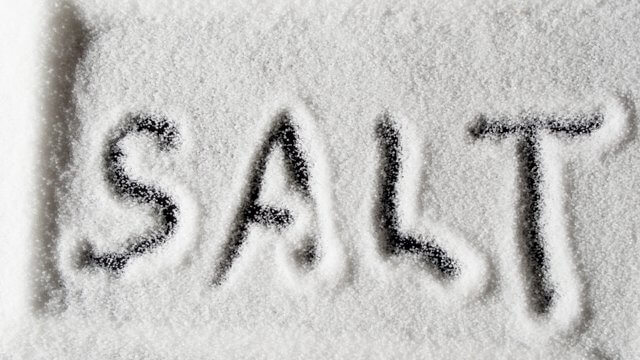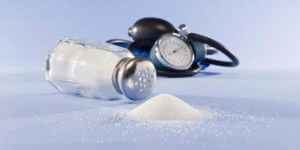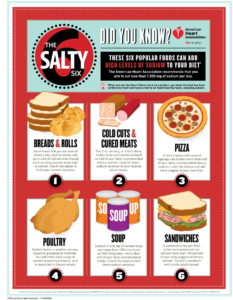Breaking Up with Sodium

This year’s theme for National Nutrition Month is “Savor the Flavor of Eating Right”. One of the inspirations for this theme is to educate the public to appreciate the flavor of foods, and how to utilize foods to provide flavor without the addition of unwanted nutrients. One of the main nutrients that we look to limit is sodium, an essential nutrient that has been linked to heart disease when consumed in excess amounts. Given that heart disease is the #1 killer in the US, learn why breaking up with sodium will be the best relationship you could ever end – and make your heart happy at the same time. I grew up in a very Italian family. All of my relatives think nothing of dumping salt into any recipe. And because measuring spoons don’t exist in the Italian culture (because you just add “a little of this, and a little of that”), the lack of control on salt intake is escalated. Even today, with all we know about sodium in the diet, my mom will still complain that she didn’t add enough salt to a dish, even though she’s the only one who seems to notice. On the other hand, I have always limited excess salt in my foods, so I am now hyper-sensitive to salt flavors. Mr E seems to fall somewhere in the middle.
What is Sodium & The Connection to Heart Disease?
Sodium is actually a very important mineral for our bodies- it regulates fluids, controls nerve signals, and affects muscle function. Your kidneys are the Britta Filter that help regulate sodium levels by getting rid of excess levels. However, when we have too much sodium in the blood, the kidneys can become overworked and can’t keep up with the workload. Think about when your boss gives you another project to work on before you have a chance to finish the current task at hand- the workload starts to pile up, right? Same goes for the amount of sodium  in the blood- if it can’t get filtered, it’s left to “pile up” in the bloodstream, and it takes extra water along for the ride, causing an increase in blood volume. This can lead to added pressure on the blood vessels, which can eventually lead to the vessel walls weakening and building up a gunk known as plaque that further blocks blood flow. And just like you get tired when you’re overworked, your heart feels the exact same way as it pumps overtime to produce adequate blood for the body. Eventually you may pass out from exhaustion when working at an intense pace without adequate rest – and your heart can eventually call it quits as well, ultimately leading to heart failure.
in the blood- if it can’t get filtered, it’s left to “pile up” in the bloodstream, and it takes extra water along for the ride, causing an increase in blood volume. This can lead to added pressure on the blood vessels, which can eventually lead to the vessel walls weakening and building up a gunk known as plaque that further blocks blood flow. And just like you get tired when you’re overworked, your heart feels the exact same way as it pumps overtime to produce adequate blood for the body. Eventually you may pass out from exhaustion when working at an intense pace without adequate rest – and your heart can eventually call it quits as well, ultimately leading to heart failure.
Increasing Your Waistline, Shrinking Your Bones
Sodium also has a negative impact on your waistline and bone health. As the extra sodium pulls more water into the bloodstream, it can cause weight gain and bloating. This is why a good daily sweat can help relieve excess levels of sodium and water in the body. The extra sodium in your blood can also cause calcium to be lost from the bones, leading to osteoporosis. And weak bones have a hard time supporting all that extra weight.
Where do we Find Sodium?
A common misconception is that sodium and salt are the same thing. This is a false statement. Table salt is comprised of 40% sodium and 60% chloride – and a teaspoon of salt will serve you approximately 2300 mg sodium. This is the maximum DAILY recommendation per the American Heart Association. Sodium in the diet comes from three sources:
Naturally Occurring: Many food items, including beets, celery, and milk, all naturally contain sodium
Processed Foods: If it comes in a can, box, frozen dinner, or from the deli counter, that food is guaranteed to be full of sodium. This is because sodium helps preserve foods (helpful in the days of the Mayflower, but not so much now). Processed foods account for 75% of our sodium consumption.
Added Salt: If you’ve ever seen the size of the salt containers in a restaurant, they put the Costo versions to shame. Salt is a key ingredient in the majority of restaurant foods. Unfortunately, we have very little control over this. But what we DO have control over is the salt we add to our foods using the salt shaker.
Be A Control Freak
One of the major contributors of salt in the diet is from processed foods and foods consumed in restaurants. Have more control over what’s going in your body by limiting take-out and pre-packaged foods. Control your salt intake at home by making some smart swaps. After some time away form the salt shaker, you may find your tastebuds have adjusted and become more sensitive to salt in foods.
TIME TO DITCH THE SALT SHAKER, SHOP THE PERIMETER OF THE STORE, AND ADD MORE FRESH WHOLESOME FOODS INTO YOUR LIFE. HOW HAVE YOU STARTED BREAKING UP WITH SODIUM?
CHECK BACK TOMORROW FOR TIPS ON SWAPPING THE SALT!
SHARE YOUR TIPS BY TAGGING ME ON SOCIAL MEDIA AND USING #FOODANDMOVEMENT.



[…] RELATED: BREAKING UP WITH SODIUM […]
[…] RELATED: Breaking Up with Sodium […]